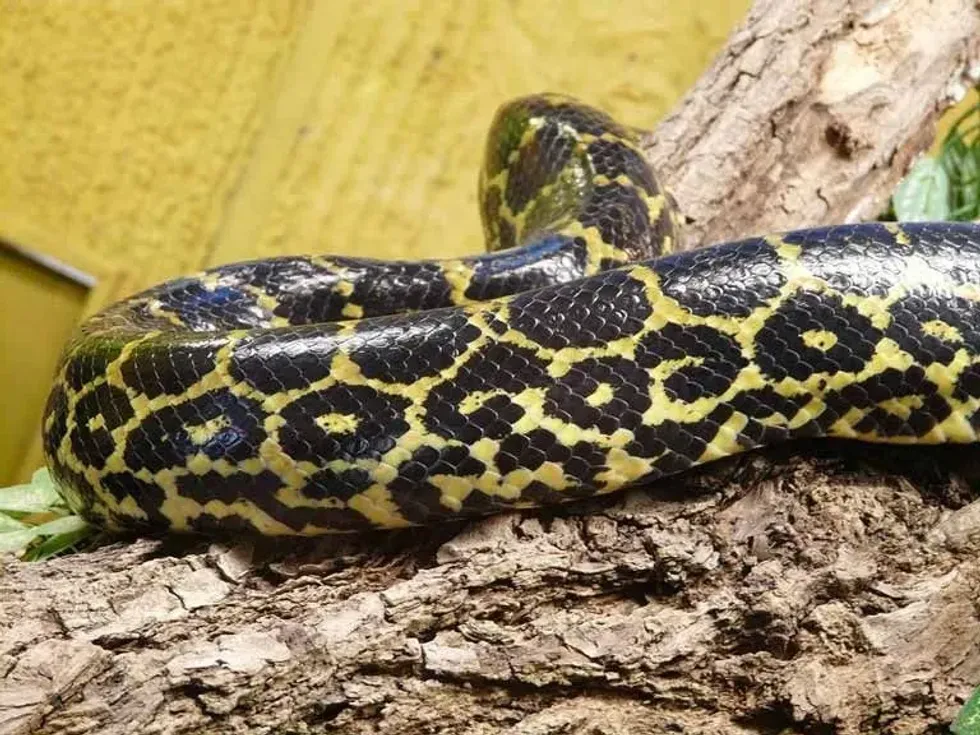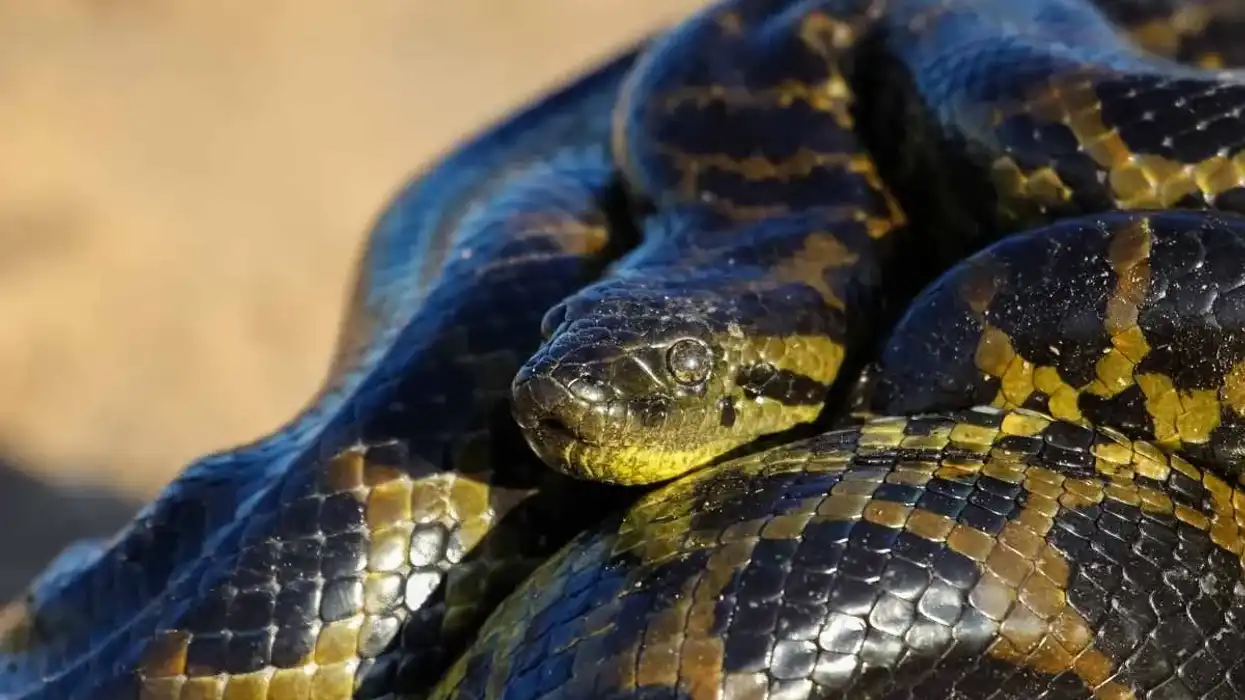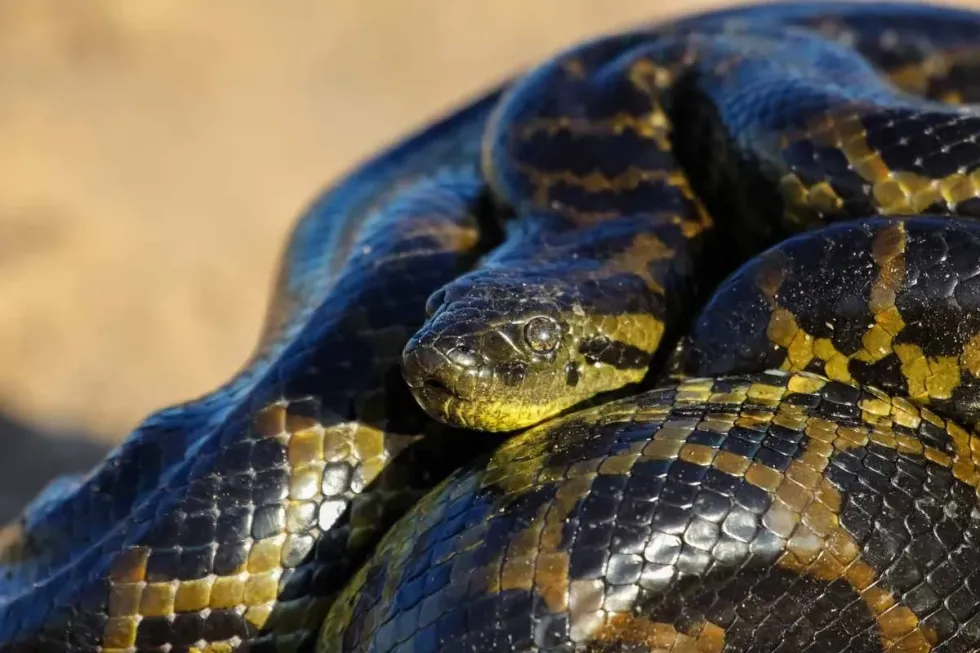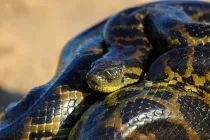Fun Yellow Anaconda Facts For Kids

Content
- What type of animal is a yellow anaconda?
- What class of animal does a yellow anaconda belong to?
- How many yellow anacondas are there in the world?
- Where does the yellow anaconda live?
- What is a yellow anaconda's habitat?
- Who do yellow anacondas live with?
- How long does a yellow anaconda live?
- How do they reproduce?
- What is their conservation status?
- What do yellow anacondas look like?
- How cute are they?
- How do they communicate?
- How big is a yellow anaconda?
- How fast can a yellow anaconda move?
- How much does a yellow anaconda weigh?
- What are their male and female names of the species?
- What would you call a baby yellow anaconda?
- What do they eat?
- Are they aggressive?
- Would they make a good pet?
- Did you know...
- How do yellow anacondas protect themselves?
- How do yellow anacondas 'hear'?
The two species of constricting anacondas, the green, and the yellow anacondas are found in the tropical region of South America. In a size comparison between yellow anaconda vs green anaconda, the latter emerges as the bigger snake.
They can be differentiated mainly by the differences in their geographic locations and their respective sizes. However, a yellow anaconda (Eunectes notaeus), the South American boa species is one of the largest snakes in the world.
The name anaconda is commonly used for the species Eunectes which is a part of the boa family genus. Eunectes means good swimmers.
The name yellow was added due to the yellowish appearance of their skin. The color pattern of yellow anacondas includes colors like yellow, golden tan, or the yellowish-green pattern with black and dark brown colored spots and patches running all over the body.
The spurs on the scales of a male are larger than that of the females.
They can also take camouflage depending on the habitat in which they are present. The habitats of yellow anacondas include marshy swamps or rivers in tropical regions.
They can also reside on land. These dangerous snakes have been banned in certain places and the rights to hold them captive for research purposes are snatched.
Yellow anacondas, although non-venomous, are aggressive predators who kill by constriction. If you are interested to know more about the amazing family of yellow anacondas, keep on reading these fascinating facts.
If you find our content interesting then do check out the cottonmouth snake and the copperhead snake.
Yellow Anaconda Interesting Facts
What type of animal is a yellow anaconda?
A yellow anaconda is one of the world's largest snakes belonging to the species of boa. These non-venomous snakes who are smaller in size than their relative species the green anaconda, kill their prey by constriction.
What class of animal does a yellow anaconda belong to?
Yellow anacondas are reptiles in nature and fall under the class Reptilia.
How many yellow anacondas are there in the world?
The population of yellow anacondas is gradually decreasing. The total number of these animals that are present in the world is currently unknown.
Anacondas are predators who have the capability to influence, and are influenced by, the population of other species. Yellow anacondas have a very resilient population because they change their reproductive habits according to their changing environmental conditions.
The main threats or cause of concern for their decreasing population is worldwide climate change as well as the destruction of their habitat. The Yellow Anaconda Management Program, or YAMP, has tried to seek measures that will favor the conservation of anacondas.
However, overexploitation of their population can severely affect the gender ratio of this species. The current guidelines that are being followed for harvesting these snakes are considered to be perfect for them as they have a positive effect on their population.
Where does the yellow anaconda live?
The yellow anacondas of the boa species are the exclusive natives of the southern part of South America. They are found to the east of the Andes Mountains in the tropical waters.
The entire range of the Paraguay River is home to most of the yellow anacondas of the world. The tributaries of the Paraguay River from the northern part of Uruguay, western Brazil to northeastern Argentina, and from the Pantal region located in Bolivia contain these anacondas in large numbers.
They come on the shore to capture their prey.
Floods are very common in the areas where they are found and the humidity is relatively high, around 80%-90%. Some species were introduced to Florida but their ability to reproduce in that place is unknown.
What is a yellow anaconda's habitat?
Yellow anacondas prefer to live in aquatic habitats. They include marshes and swamps, and on-shore, the banks of slow-moving rivers and streams that are covered with thick bushes.
A yellow anaconda widely searches for its food in the wetland areas and in shallow waters. Since they spend most of their lives in the water, yellow anacondas are called 'water boas'. These snakes float on the top of the water surface keeping their snouts mostly inside the water.
Sometimes they also roam in forests generally to find prey. In dry seasons they go inside holes near the river banks since they retain water and during the rainy months, they stay in treeless flooded areas to prey on aquatic animals.
Who do yellow anacondas live with?
On social grounds, yellow anacondas are solitary animals. They rarely interact with other species in the wild. During their breeding season, the males go out in search of females to complete their mating process.
How long does a yellow anaconda live?
A yellow anaconda typically lives for about 15 years- 20 years in the wild. If held captive for scientific research, they can live a little over 20 years.
The highest age recorded of a surviving yellow anaconda is 23 years old. The young yellow anacondas are vulnerable to prey so their mortality rate is very high. Human activities like overhunting have also had an effect on the lives of yellow anacondas decreasing the years of their average lifespan.
How do they reproduce?
The female yellow anacondas release a chemical known as pheromones into the air. The males get attracted to that scent and approach the female to mate.
Multiple males compete to mate with a single female at the same time. At this time, anacondas form breeding balls that consist of single females and multiple males.
These breeding balls might remain intact for weeks. Generally, in the competition among all the males to reach the female, the largest snake emerges as the winner and breeds with the female snake.
Their entire mating process takes place in the water. Both the male and female anacondas reach sexual maturity at around three or four years of age. The gestation period of the females extends to six months.
They give birth to the young ones after incubating the eggs within their body for weeks. After that, they give birth to up to 82 live young.
The mating season of yellow anacondas starts in April and lasts until May. The young ones are left to be independent as soon as they are born without any significant parental care.
What is their conservation status?
The boa species of yellow anacondas are enlisted under the Threatened category of the International Union for Conservation of Nature or IUCN Red List. They have fallen prey to continuous over-hunting which has decreased their population.
Trading in yellow anacondas is banned in certain South American countries. Despite that, some countries maintain quotas for exporting a certain number of snakes for conducting research or for the annual pet trade. Since humans are scared to be around such large aquatic species, they are comparatively less exploited than the other boas.
Yellow Anaconda Fun Facts
What do yellow anacondas look like?

A giant yellow anaconda (Eunectes notaeus) is way thicker and more muscular than other boa species. Their neck is muscular that finishes in a narrow but large head.
The eyes and the nostrils lie on the top of the head. This feature facilitates their ability to see above the water surface while their body remains submerged.
The body is covered with smooth scales that tend to get larger as they reach the posterior end of the snake. The scales of a yellow anaconda have a yellowish-green tinge with black or dark brown bands that overlap the spots spread over the entire body.
A female snake is generally larger than a male snake in this species. They can camouflage in green vegetation or dirty water.
How cute are they?
Yellow anacondas can produce up to 80 babies who are around 23 in (60 cm) at the time of birth. These small snakes appear cute but as they get older, they become very aggressive and are often feared by humans rather than being appreciated for their looks.
How do they communicate?
Yellow anacondas live by themselves most of the time so communication between them is secondary. During the time of mating, the females produce a pheromone that attracts potential mates.
They communicate by rubbing each other. Like all anacondas, a yellow anaconda possesses heat-sensing pits that are located along its mouth. The function of these pits is that they help to locate their warm-blooded preys who give of their body heat and these sensory pits are signaled by that.
The fork-like tongue in this animal helps them to navigate through the environment and locate their prey. They pick up vibrations rather than noises through their jaws.
How big is a yellow anaconda?
The yellow anaconda is one of the largest snakes in the world. The length of a full-grown yellow anaconda snake of the species ranges from 11 ft - 14 ft (3.3 m - 4.4 m).
Female yellow anaconda's size is comparatively longer than the males and their lengths can reach up to 15 ft (4.6 m). They are similar in size to their relative species, the green anaconda (Eunectes Murinus).
How fast can a yellow anaconda move?
Yellow anacondas live a solitary life both on land and in water. They catch preys from the water in the rainy season and goes to the season during drought.
Due to their size, these boas might sometimes face difficulty moving fast. This cumbersome moving vanishes when they are in the water, In water, yellow anacondas move very swiftly especially when they are after their prey. The information regarding the exact speed of these boas is not specified properly specified.
How much does a yellow anaconda weigh?
The weight of a fully grown adult yellow anaconda commonly varies from 55 - 77lb (25kg - 35kg). The highest weight of a yellow anaconda that was recorded is 121 lb (55 kg).
What are their male and female names of the species?
As yellow anacondas are a boa species of snake, they do not have any different names for the male and the female like all other snakes. However, these anacondas are also known popularly as Paraguayan anaconda based on their geographical location.
What would you call a baby yellow anaconda?
A baby or young yellow anacondas, like all the other babies of snakes, is known as a hatching snake, a snakelet, or a neonate.
What do they eat?
Yellow anacondas are carnivorous snakes. They are predators who eat in the water as well as on land.
Unlike other snakes, anacondas are not venomous. They kill their prey by the method of constriction where they subdue their prey. These snakes prefer to attack their prey from water and the prey mostly drown rather than being suffocated by the snake.
These boa species can live without food for quite a long stretch. The most favorable time for them to prey are the months between June and November.
At that time, since floods are rare, many wading birds or offshore birds come to the river banks. They are the snake's most common prey. Yellow anacondas eat aquatic and semi-aquatic animals that include a wide range of small mammals, birds, amphibians, eggs, reptiles, and fishes.
This animal swallows any vertebrate that it can catch like capybara, peccaries, or brocket deer. The practice of cannibalism has also been found in this species of boas.
Are they aggressive?
Anacondas tend to be more aggressive than other snakes. A yellow anaconda that has resisted in the wild is considered to be very dangerous. When bred in captivity, the anacondas appear to be a bit more docile than their wild cousins but still, they can turn out to be really harmful and full of aggression.
Would they make a good pet?
Anacondas make dangerous pets rather than good ones. It is unlikely to be fond of petting an anaconda.
In such a case, it is absolutely not safe to make a yellow anaconda pet, and similarly, yellow anacondas do not make a good pet for any inexperienced keeper. They are constrictors and these large snakes have a lot of strength that needs to be respected.
Did you know...
Eunectes notaeus, yellow anaconda, tend to be active during the night and as a result, they have a strong night vision.
How do yellow anacondas protect themselves?
Similar to all the species of anaconda, yellow anacondas are non-venomous snakes who kill their prey by constriction. To protect themselves from their predators, they inflict painful bites. However, humans have been known to kill this snake out of fear whenever they enter a human-occupied space.
How do yellow anacondas 'hear'?
Yellow anacondas do not strong hearing. For this reason, their jaws have adapted to pick up any kind of vibration that approaches the snake. This feature helps them to be aware of any nearby danger as well as in the search for food.
Here at Kidadl, we have carefully created lots of interesting family-friendly animal facts for everyone to discover! Learn more about some other reptiles including the green anaconda and the rattlesnake.
You can even occupy yourself at home by drawing one on our Yellow anaconda coloring pages.
We Want Your Photos!
More for You
Bachelor of Arts specializing in Journalism and Mass Communication, Postgraduate Diploma in Sports Management

Moumita DuttaBachelor of Arts specializing in Journalism and Mass Communication, Postgraduate Diploma in Sports Management
A content writer and editor with a passion for sports, Moumita has honed her skills in producing compelling match reports and stories about sporting heroes. She holds a degree in Journalism and Mass Communication from the Indian Institute of Social Welfare and Business Management, Calcutta University, alongside a postgraduate diploma in Sports Management.
Bachelor of Law

Abdulqudus MojeedBachelor of Law
A versatile professional with a passion for creative writing and technology. Abdulqudus is currently pursuing his Bachelor of Law from the University of Lagos and has experience as a tutor, intern assistant, and volunteer. He possesses strong organizational skills and is a detail-oriented person.
Disclaimer
1) Kidadl is independent and to make our service free to you the reader we are supported by advertising. We hope you love our recommendations for products and services! What we suggest is selected independently by the Kidadl team. If you purchase using the Buy Now button we may earn a small commission. This does not influence our choices. Prices are correct and items are available at the time the article was published but we cannot guarantee that on the time of reading. Please note that Kidadl is a participant in the Amazon Services LLC Associates Program, an affiliate advertising program designed to provide a means for sites to earn advertising fees by advertising and linking to Amazon. We also link to other websites, but are not responsible for their content.
2) At Kidadl, we strive to recommend the very best activities and events. We will always aim to give you accurate information at the date of publication - however, information does change, so it’s important you do your own research, double-check and make the decision that is right for your family. We recognise that not all activities and ideas are appropriate for all children and families or in all circumstances. Our recommended activities are based on age but these are a guide. We recommend that these ideas are used as inspiration, that ideas are undertaken with appropriate adult supervision, and that each adult uses their own discretion and knowledge of their children to consider the safety and suitability. Kidadl cannot accept liability for the execution of these ideas, and parental supervision is advised at all times, as safety is paramount. Anyone using the information provided by Kidadl does so at their own risk and we can not accept liability if things go wrong.
3) Because we are an educational resource, we have quotes and facts about a range of historical and modern figures. We do not endorse the actions of or rhetoric of all the people included in these collections, but we think they are important for growing minds to learn about under the guidance of parents or guardians.







